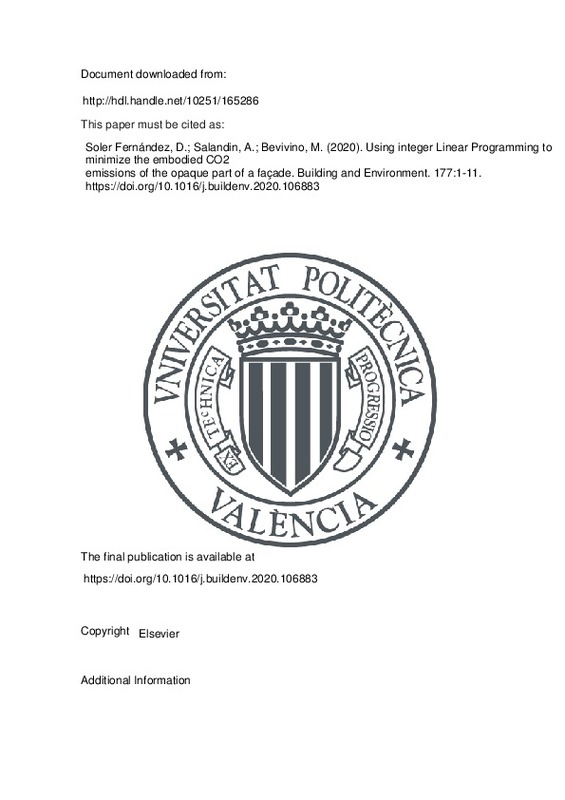Huang, P.-J., Huang, S.-L., & Marcotullio, P. J. (2019). Relationships between CO2 emissions and embodied energy in building construction: A historical analysis of Taipei. Building and Environment, 155, 360-375. doi:10.1016/j.buildenv.2019.03.059
Lolli, N., Fufa, S. M., & Inman, M. (2017). A Parametric Tool for the Assessment of Operational Energy Use, Embodied Energy and Embodied Material Emissions in Building. Energy Procedia, 111, 21-30. doi:10.1016/j.egypro.2017.03.004
Abd Rashid, A. F., & Yusoff, S. (2015). A review of life cycle assessment method for building industry. Renewable and Sustainable Energy Reviews, 45, 244-248. doi:10.1016/j.rser.2015.01.043
[+]
Huang, P.-J., Huang, S.-L., & Marcotullio, P. J. (2019). Relationships between CO2 emissions and embodied energy in building construction: A historical analysis of Taipei. Building and Environment, 155, 360-375. doi:10.1016/j.buildenv.2019.03.059
Lolli, N., Fufa, S. M., & Inman, M. (2017). A Parametric Tool for the Assessment of Operational Energy Use, Embodied Energy and Embodied Material Emissions in Building. Energy Procedia, 111, 21-30. doi:10.1016/j.egypro.2017.03.004
Abd Rashid, A. F., & Yusoff, S. (2015). A review of life cycle assessment method for building industry. Renewable and Sustainable Energy Reviews, 45, 244-248. doi:10.1016/j.rser.2015.01.043
Robati, M., Daly, D., & Kokogiannakis, G. (2019). A method of uncertainty analysis for whole-life embodied carbon emissions (CO2-e) of building materials of a net-zero energy building in Australia. Journal of Cleaner Production, 225, 541-553. doi:10.1016/j.jclepro.2019.03.339
Chastas, P., Theodosiou, T., Kontoleon, K. J., & Bikas, D. (2018). Normalising and assessing carbon emissions in the building sector: A review on the embodied CO 2 emissions of residential buildings. Building and Environment, 130, 212-226. doi:10.1016/j.buildenv.2017.12.032
Surahman, U., Higashi, O., & Kubota, T. (2015). Evaluation of current material stock and future demolition waste for urban residential buildings in Jakarta and Bandung, Indonesia: embodied energy and CO2 emission analysis. Journal of Material Cycles and Waste Management, 19(2), 657-675. doi:10.1007/s10163-015-0460-1
Brütting, J., Vandervaeren, C., Senatore, G., De Temmerman, N., & Fivet, C. (2020). Environmental impact minimization of reticular structures made of reused and new elements through Life Cycle Assessment and Mixed-Integer Linear Programming. Energy and Buildings, 215, 109827. doi:10.1016/j.enbuild.2020.109827
Taffese, W. Z., & Abegaz, K. A. (2019). Embodied Energy and CO2 Emissions of Widely Used Building Materials: The Ethiopian Context. Buildings, 9(6), 136. doi:10.3390/buildings9060136
Sicignano, E., Di Ruocco, G., & Melella, R. (2019). Mitigation Strategies for Reduction of Embodied Energy and Carbon, in the Construction Systems of Contemporary Quality Architecture. Sustainability, 11(14), 3806. doi:10.3390/su11143806
Mehrjerdi, H., & Rakhshani, E. (2019). Optimal operation of hybrid electrical and thermal energy storage systems under uncertain loading condition. Applied Thermal Engineering, 160, 114094. doi:10.1016/j.applthermaleng.2019.114094
Eshraghi, A., Salehi, G., Heibati, S., & Lari, K. (2019). Developing operation of combined cooling, heat, and power system based on energy hub in a micro-energy grid: The application of energy storages. Energy & Environment, 30(8), 1356-1379. doi:10.1177/0958305x19846577
Wang, D., Wu, R., Li, X., Lai, C. S., Wu, X., Wei, J., … Lai, L. L. (2019). Two-stage optimal scheduling of air conditioning resources with high photovoltaic penetrations. Journal of Cleaner Production, 241, 118407. doi:10.1016/j.jclepro.2019.118407
Zhang, Y., Campana, P. E., Lundblad, A., Zheng, W., & Yan, J. (2019). Planning and operation of an integrated energy system in a Swedish building. Energy Conversion and Management, 199, 111920. doi:10.1016/j.enconman.2019.111920
Bojic, M., & Trifunovic, N. (2000). Linear programming optimization of heat distribution in a district-heating system by valve adjustments and substation retrofit. Building and Environment, 35(2), 151-159. doi:10.1016/s0360-1323(99)00013-x
Privitera, G., Day, A. R., Dhesi, G., & Long, D. (2011). Optimising the installation costs of renewable energy technologies in buildings: A Linear Programming approach. Energy and Buildings, 43(4), 838-843. doi:10.1016/j.enbuild.2010.12.003
Lindberg, K. B., Doorman, G., Fischer, D., Korpås, M., Ånestad, A., & Sartori, I. (2016). Methodology for optimal energy system design of Zero Energy Buildings using mixed-integer linear programming. Energy and Buildings, 127, 194-205. doi:10.1016/j.enbuild.2016.05.039
Ogunjuyigbe, A. S. O., Ayodele, T. R., & Oladimeji, O. E. (2016). Management of loads in residential buildings installed with PV system under intermittent solar irradiation using mixed integer linear programming. Energy and Buildings, 130, 253-271. doi:10.1016/j.enbuild.2016.08.042
[-]







![[Cerrado]](/themes/UPV/images/candado.png)


